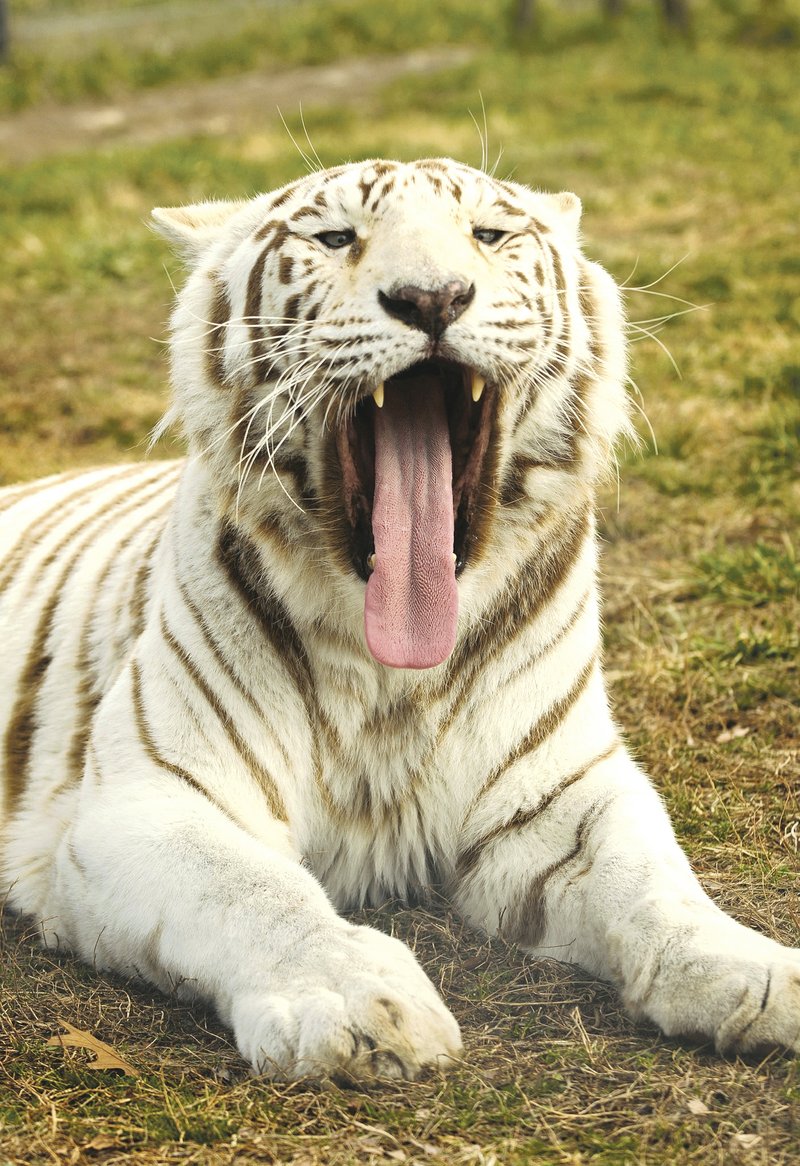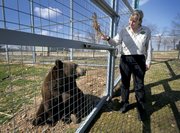Tsavo rolled on his back, his African lion belly up to the sun. Nearby, Mac, an 8-year-old tiger, relaxed under a platform in the shade.
Better than a warm winter day, however, are the new habitats where Tsavo, Mac and 98 other animals are living the good life at Turpentine Creek Wildlife Refuge in Eureka Springs.
Turpentine Creek Wildlife Refuge
When: 9 a.m. to 6 p.m. daily
Tours: Walking and trolley tours available daily
Where: 239 Turpentine Creek Lane; seven mile south Eureka Springs on Arkansas 23
Admission: $20, adults; $15, teenagers; $10, ages 4 to 12, senior citizens and veterans; free, younger than 3.
Information: 253-5841, turpentinecreek.org
Turpentine Creek
Cat facts
• Big cat rescue organizations spent about $10,000 a year caring for just one animal, according to the national average. Turpentine Creek Wildlife Refuge receives no federal, state or city funding, and no financial reimbursement when an animal is rescued. The operating budget comes entirely from admission fees, gift shop sales, overnight stays in the lodging facilities and donations from private individuals. Opportunities are available to “adopt” the big cats living at the rescue.
• Now is the time to visit Turpentine Creek Wildlife Refuge. The animals are most active when daytime temperatures are mild — not too hot or not too cold. The first tour of the day often finds the cats re-investigating their habitats after being released from their dens. The animals also ramp up activity about an hour and a half before feeding time at 4:2o p.m.
• The Jackson family — including 11-year-old Tanya — began caring for rescue cats in 1978 while living in East Texas. In 1991, a breeder and black market dealer on the run from the law left 42 big cats with the Jacksons, who found a temporary refuge in Eureka Springs, which the family later purchased. Turpentine Creek Wildlife Rescue opened to the public in 1992 in Eureka Springs.
• In the United States, thousands of residents keep dangerous big cats in their back yards, basements, garages and warehouses. People acquire these animals as pets and soon find they have made a grave decision, turning to refuges for help.
• Several of the cats rescued from Mountainburg remain at Rescue Ridge, a facility elsewhere on the Turpentine Creek sits, because they are still uncomfortable with human contact — including Joella, the white tiger pictured with this story.
• The next phase of improvements at Turpentine Creek include a new entrance, visitor and information center, cafe and giftshop, all designed to improve the human experience.
SOURCE: Tanya Smith, turpentinecreek.org
Coming Next
Turpentine Creek, in coordination with KaleidoKites of Eureka Springs, will host the annual Art With an Altitude Kite Fest on March 26.
Participants can make kites on site or buy kites. There will be food, music and family activities to fill the day, and because Kite Fest falls the day before Easter this year, there will be an Easter Egg hunt at 3 p.m. for kids 8 and under.
Flying a kite and participating in Kite Fest activities is free, but normal admission prices apply to enter the refuge.
Information: KaleidoKites at (479) 253-6596.
"When you see a tiger lying like that, you know he's totally contented," said Tanya Smith, founder and the president of the big cat rescue, which offers a lifetime home for abused and abandoned "big cats."
Rayn, a regal lady tiger, rested on her platform made of old fire hoses. BB King and Mo had balls, ropes and other toys waiting for playtime in their habitat. Duke spent his tiger time "out here and up there," Smith said.
And Bam Bam greeted guests by sticking out his tongue through the wire fence surrounding his habitat. Scattered throughout the habitat were ripped brown branches of old, brittle Christmas trees, donated to the refuge for animal enrichment. The 8-year-old grizzly bear -- one of only 20 in Arkansas -- had spent the day tearing them up.
"He had a good time today," Smith said with a contented smile.
As Smith drove around the habitats that day, a barn owl flew from the top of a lion habitat to a tree on a wooded hillside of the rescue. Smith stopped her car and watched, taking a few pictures with her cell phone.
Intern Kelly Hurlbut of North Carolina said the owl had been hanging around a lion's habitat for a few days. "I think he has a thing for Willy," she said.
"I guess it's an owl rescue, too," Smith said with a small smile and rueful shake of the head. "We're suckers for all animals. It's hard to say no."
NEW DIGS
Lions, tigers and other exotic animals brought to Turpentine Creek can come from the most desperate situations: small, squalid housing, poor nutrition, injuries not attended.
"Some of them don't know how to walk on the grass," Smith said. "They haven't seen it since they were cubs."
Soon, each resident animal at Turpentine Creek will live in a large, bright grassy area -- some with trees and hillside slopes. Many animals already reside in their new homes, with enrichment structures, shaded areas and night quarters. These habitats range in size from 8,000 to 20,000 square feet -- life-changers for cats rescued from 4- by 4-foot cages.
"Open habitats have been our dream for a long time," said Smith, who 24 years ago opened to the public the rescue her parents started. "It gives the animal space, and helps us make their lives richer."
Cracked septic tanks have been cut in half and donated to the rescue for the cost of shipping, Smith explained. Re-purposed as nearly indestructible night quarters, these dens provide warm and cool refuge from the range of Ozark weather. Staff members add pools and misters in the summer and blankets and hay during the winter. One older lion found great relief from her arthritis from a heating pad, developed by rescue staff and the University of Arkansas engineering department, Smith noted.
With the new habitats, "visitors get to view the animals up close and personal," Smith said. "But they also will see the cats in large, natural areas, doing the things the animals love to do."
The U.S. Department of Agriculture and the Arkansas Game & Fish Department issued new regulations as to the living conditions for big cats and gave zoos and rescues a couple of years to upgrade their facilities, Smith said, although plans already were in place for the habitats.
Fencing must be 12 feet tall -- with an additional 3 feet overhanging the fence as a jump guard -- or 15 feet for open enclosures. The mesh in the wire -- all of which is welded together -- must be no larger than 4 by 4 inches, Smith listed.
"We're working as fast and steady as we can," she said. The cats are enjoying 54 of the new habitats, with just two more under construction.
In 2012-13, 28 cats were rescued from another big cat rescue in Mountainburg. As the owner got older, the care for the enormous cats she treated as pets diminished along with her health. Nearly overwhelmed by the magnitude of the operation, the staff of Turpentine Creek worked for more than a year to get all those cats rescued and settled, Smith said.
In the midst of this crush came a call about Sadie, a tiger kept as a pet by a couple in Elkins. The couple were going through a divorce, and the judge gave them five days to get rid of the cat. The staff at Turpentine Creek found her a space at the refuge and treated her broken leg, which left her with a permanent limp.
"We do anything we can manage," Smith said. "Oftentimes, if we do not take them, the animal will be destroyed. And some of these are endangered species."
On that same winter day Tsavo snoozed, Hurlbut and other interns at the rescue -- who also care for the animals daily -- stood atop ladders spraying welded wire fence with rust protection. Suz Manning-Osborn, also of North Carolina, helped bend fence posts.
Construction of the new habitats will continue daily, with an "all hands on deck" attitude until they are completed.
"The interns and staff work until stuff gets done," Smith said.
A class of 12 to 18 interns comes to the rescue every six months, college graduates with degrees in zoology, biology and related fields. There they earn practical, daily experience working with the cats, tackling maintenance and serving as tour guides. Several from the program now work at major zoos around the world, and others attend veterinary school.
Other new features at Turpentine Creek include educational panels along the tour path. "If we're not educating them along the way, we are wasting time," Smith said.
Various groups will spend spring break time building more habitats. Local volunteers constructed pergolas along the walkway to provide shade for visitors and planted and care for the gardens that greet them.
In addition to the new habitats -- materials for each costing $25,000 to $50,000 -- construction will be finished next month on a complete 4,800-square-foot veterinary clinic. An architect donated his services, and through donations from the public, the clinic was built for $308,000, with the goal nearly reached for $154,000 needed for equipment, Smith said. Another dream for the rescue is the money to add a veterinarian to the staff.
The new facility includes a hospital which will allow veterinarians to come to the rescue to complete procedures and testing and the ability for video conferencing, eliminating the need for travel in some cases. Previously, a cat had to be sedated then hauled 30 miles away to a veterinary office in Green Forest and monitored back at the rescue while it revived from the sedation, Smith said.
"Our goal is to get them off the road and back home," she said.
"A small raccoon, a possum, anything can bring disease in," Smith continued. Big cats can suffer the same diseases as domestic cats, plus distemper, she added.
Most of the lifetime residents of Turpentine Creek are older -- with any age past 11 considered "geriatric," Smith said. In fact, 50 cats at the rescue get supplements like glucosamine to ease the pains of aging.
And cats that come to the rescue from horrible conditions often need health care. Thor, a 15-year-old African king lion, spends his days in a habitat outside Smith's office window as she monitors his medical conditions. When he came to the rescue, he had burns and scars from sitting in his own urine and half his tail was missing, she reported.
But Thor can still issue a majestic roar. Pulled up from the lion's belly, a visitor will feel it in his own. And the other lions, content at the rescue ... roar in response.
NAN Our Town on 03/17/2016


